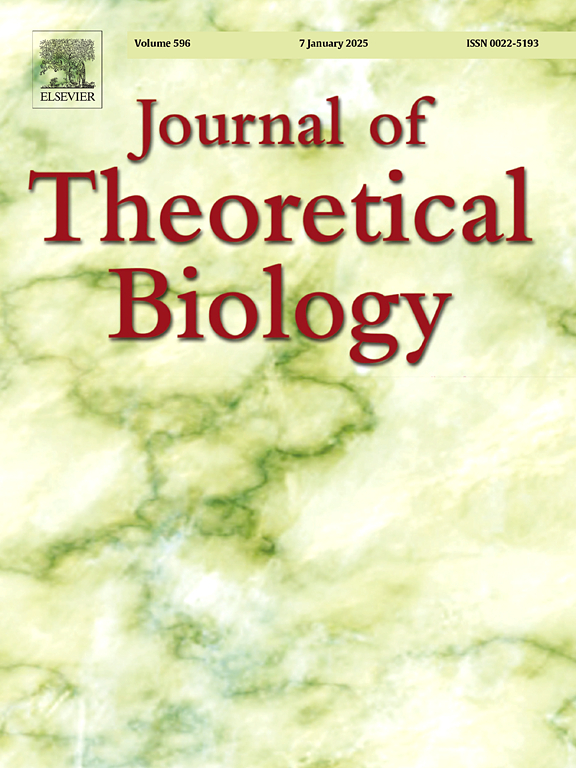Optimal resource allocation in micro-organisms under periodic nutrient fluctuations
IF 1.9
4区 数学
Q2 BIOLOGY
引用次数: 0
Abstract
Although microorganisms often live in dynamic environments, most studies, both experimental and theoretical, are carried out under static conditions. In this work, we investigate the issue of optimal resource allocation in bacteria growing in periodic environments. We consider a dynamic model describing the microbial metabolism under varying conditions, involving a control variable quantifying the protein precursors allocation. Our objective is to determine the optimal strategies maximizing the long-term growth of cells under a piecewise-constant periodic environment. Firstly, we perform a theoretical analysis of the resulting optimal control problem (OCP), based on the application the Pontryagin’s Maximum Principle (PMP). We determine that the structure of the optimal control must be bang–bang, with possibly some singular arcs corresponding to optimal equilibria of the system. If the control presents singular arcs, then these can only be reached and left through chattering arcs. We also use a direct optimization method, implemented in the BOCOP software, to solve the studied OCP. Our study reveals that the optimal solution over a large time horizon is related to the one over a single period of the varying environment with periodic constraints. Moreover, we observe that the maximal average growth rate attainable under periodic conditions can be higher than the one under a constant environment. We further extend our analysis to conduct a qualitative comparison between the predictions from our model and some recent biological experiments on E. coli. This analysis particularly highlights the mechanisms of action of the ppGpp signaling molecule, thus providing relevant explanations of the experimental observations. In conclusion, our study corroborates previous research indicating that this molecule plays a crucial role in the regulation of resource allocation of protein precursors in E. coli.
周期性养分波动下微生物的最佳资源分配。
虽然微生物经常生活在动态环境中,但大多数研究,无论是实验研究还是理论研究,都是在静态条件下进行的。在这项工作中,我们研究了在周期性环境中生长的细菌的最佳资源分配问题。我们考虑了一个描述不同条件下微生物新陈代谢的动态模型,其中涉及一个量化蛋白质前体分配的控制变量。我们的目标是确定在片断恒定的周期性环境下最大化细胞长期生长的最优策略。首先,我们基于庞特里亚金最大原则(PMP)的应用,对由此产生的最优控制问题(OCP)进行了理论分析。我们认为,最优控制的结构必须是 "砰-砰 "式的,可能会有一些奇异弧线与系统的最优均衡点相对应。如果控制出现奇异弧,那么这些奇异弧只能通过颤动弧到达或离开。我们还使用 BOCOP 软件中的直接优化方法来求解所研究的 OCP。我们的研究表明,大时间跨度下的最优解与具有周期性约束的变化环境下的单周期最优解相关。此外,我们还发现,在周期性条件下可达到的最大平均增长率可能高于恒定环境下的增长率。我们进一步扩展了分析范围,对我们的模型预测结果和最近的一些大肠杆菌生物实验进行了定性比较。这一分析特别强调了ppGpp 信号分子的作用机制,从而为实验观察提供了相关解释。总之,我们的研究证实了之前的研究,即该分子在调节大肠杆菌蛋白质前体的资源分配中起着至关重要的作用。
本文章由计算机程序翻译,如有差异,请以英文原文为准。
求助全文
约1分钟内获得全文
求助全文
来源期刊
CiteScore
4.20
自引率
5.00%
发文量
218
审稿时长
51 days
期刊介绍:
The Journal of Theoretical Biology is the leading forum for theoretical perspectives that give insight into biological processes. It covers a very wide range of topics and is of interest to biologists in many areas of research, including:
• Brain and Neuroscience
• Cancer Growth and Treatment
• Cell Biology
• Developmental Biology
• Ecology
• Evolution
• Immunology,
• Infectious and non-infectious Diseases,
• Mathematical, Computational, Biophysical and Statistical Modeling
• Microbiology, Molecular Biology, and Biochemistry
• Networks and Complex Systems
• Physiology
• Pharmacodynamics
• Animal Behavior and Game Theory
Acceptable papers are those that bear significant importance on the biology per se being presented, and not on the mathematical analysis. Papers that include some data or experimental material bearing on theory will be considered, including those that contain comparative study, statistical data analysis, mathematical proof, computer simulations, experiments, field observations, or even philosophical arguments, which are all methods to support or reject theoretical ideas. However, there should be a concerted effort to make papers intelligible to biologists in the chosen field.

 求助内容:
求助内容: 应助结果提醒方式:
应助结果提醒方式:


